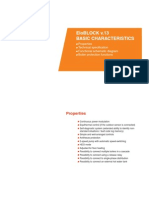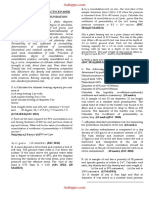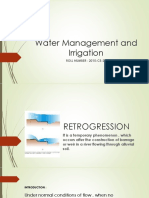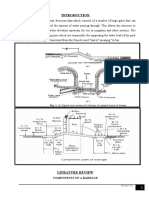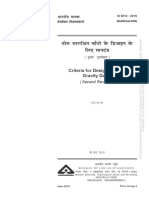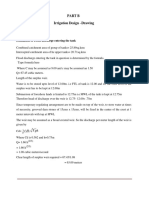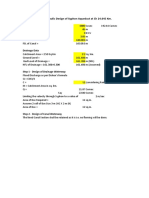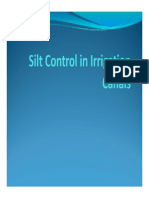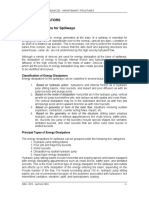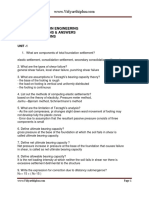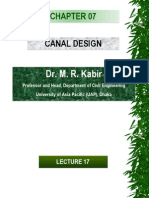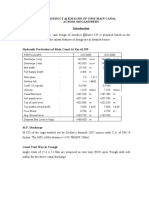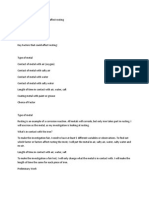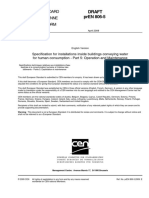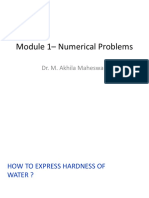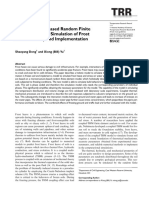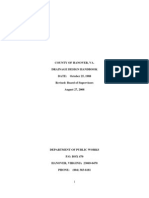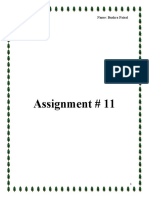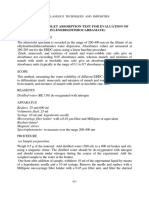On Design of A Aqueduct - Cross Drainage Work
On Design of A Aqueduct - Cross Drainage Work
Uploaded by
Shibani PatelCopyright:
Available Formats
On Design of A Aqueduct - Cross Drainage Work
On Design of A Aqueduct - Cross Drainage Work
Uploaded by
Shibani PatelOriginal Title
Copyright
Available Formats
Share this document
Did you find this document useful?
Is this content inappropriate?
Copyright:
Available Formats
On Design of A Aqueduct - Cross Drainage Work
On Design of A Aqueduct - Cross Drainage Work
Uploaded by
Shibani PatelCopyright:
Available Formats
PROJECT
ON
COMPARATIVE STUDY OF
CROSSINGS OF DRAINAGES BY
THE IRRIGATION CHANNELS
WITH SPECIAL REFERENCE TO
DESIGN OF A PROTOTYPE C.D.
WORK: AQUEDUCT
Cross drainage works are structural
elements which are constructed at the
crossing of a canal and a natural drain, so as
to dispose of drainage water without
interrupting the continuous canal supplies.
NECESSITY OF CROSS DRAINAGE
WORK:
The water shed canals do not cross natural drainages. But in actual
orientation of the canal network, this ideal condition may not be
available and the obstacles like natural drainages may be present across
the canal. So, the cross drainage works must be provided for running
the irrigation system.
At the crossing point, the water of the canal and the drainage get
intermixed. So, for the smooth running of the canal with its design
discharge the cross drainage works are required.
If the site condition of the crossing point may be such that without any
suitable structure the water of the canal and drainage cannot be
diverted to their natural directions, cross drainage works must be
provided to maintain their natural direction of flow.
TYPES OF CROSS DRAINAGE WORKS AND THEIR
SALIENT FEATURES:
A: By passing the canal over the drain. They
are of three types:
1. Aqueduct
2.Syphon aqueduct
3.Drainage syphon
AQUEDUCT & SYPHON AQUEDUCT
B: By passing the canal below the
drainage. They are of two types:
1.Super-passage
2.Canal syphon
SUPERPASSAGE AND CANAL SYPHON
C: By passing the canal through the
drain. They are of two types:
1. Level crossing
2.Inlets And Outlets
LEVEL CROSSING & INLET AND OUTLET
A)-FSL of Canal in relation to HFL of Drainage
Channel
B)-Suitable Canal alignment
C)-Topography of Terrain:
D)-Regime of Drainage Channel
E)-Foundation Strata
F)-Dewatering Requirements
G)-Ratio of Design Flood in Drainage Channel
to the Discharge in Canal
H) - Envisaged Head Loss
A) Topographical /
physical/contour data:
B) Hydraulic Data:
C) Cross section
D) Longitudinal section
FLUMING
Reduction of width of waterway of canal
CD works become economical
Possibility of hydraulic jump
To avoid this we have to control velocity of water.
TRANSITION
Provides smooth change
Avoid sudden transition and formation of eddies
At U/S section splay of 2:1 and at D/S splay of 3:1
Three methods for design of transition:-
1.Mitras transition method
2.Chaturvedis method
3.Hinds methods
MITRAS TRANSITION METHOD
B
n
=Bed width of the normal channel section
B
f
=Bed width of the flumed channel section
B
x
=Bed width at any distance x from the flumed section
L
f
= Length of transition
CHATURVEDIS TRANSITION METHOD
B
n
=Bed width of the normal channel section
B
f
=Bed width of the flumed channel section
B
x
=Bed width at any distance x from the flumed section
L
f
= Length of transition
CUTOFF WALL
Built under the floor of hydraulic structure
Reduces uplift pressure
Reduces seepage of water
Depth of cut-off is decided from the scour
depth
From laceys Normal regime scour Depth*=
R =0.473(Q/f)
1/3
From Laceys Normal Scour depth*= R=1.35(q/f)
1/3
Where
Q= Discharge w.r.t drainage
f= slit factor , normally taken as 1
q= intensity=max. velocity*max. depth
At U/S cut-off 1.5 R and D/S cut-off 2R
FLOOD ESTIMATION:
The various methods for estimation of design
flood are broadly classified as under:
Maximum Probable flood/Application of
suitable factor of safety
Return period
Rational method
Empirical flood formulae
DESIGN CONSIDERATION
I) SELECTION OF TYPE OF C.D WORK
II) HYDRAULIC DESIGN
Estimation of flood.
Design of drainage Section.
Estimation of HFL.
Design of drainage waterway.
Design of canal waterway.
Scouring
Head loss and bed level at different levels.
Design of transitions
Cont
III) STRUCTURAL DESIGN
Design of Trough .
Design of Pier.
Design of Abutment.
Design of Retaining wall.
HYDRAULIC PARTICULARS OF THE CANAL
AND DRAIN
CANAL DATA U/S D/S
Design discharge 4.905cumecs 4.905cumecs
Bed width 5.30m 5.30m
Bed level 285.596m 285.382m
Full supply level 286.846m 286.632m
Free board 0.50m 0.50m
Left bank top level 287.346m 287.132m
Right bank top level 287.346 287.132m
Left bank width 5.00m 5.00m
Right bank width 1.50m 1.50m
Velocity 0.662m/sec 0.662m/sec
Side slope 1 in 1.50 1 in 1.50
Water surface slope 1 in 4000 1 in 4000
DRAIN DATA
Catchment area 28.67km
2
Observed high flood level 282.930m
Deepest bed level 280.500m
Average bed level 281.600m
Left bank level 286.46m
Right bank level 283.74m
Angle of crossing 90degree
Direction of flow Right to left
Type of soil/Foundation Hard soil/DI/Rock Foundation
Safe bearing capacity 35t/ m
2
C/S OF DRAIN AT VARIOUS RDS
I) SELECTION OF TYPE OF C.D WORK
Terms Canal Drain
Discharge 4.905m
3
/s 198.23m
3
/s
F.S.L 286.846m --
H.F.L _ 284.3m
Bed level 285.596m 281.75m
Velocity 0.662m/s 1.5m/s
On the basis of above discussion, it can be concluded
that the best and most economical structure that can
be built is AQUEDUCT.
II) HYDRAULIC DESIGN
Step1: Estimation of flood in drain:-
Dickenss Formula says, Q = CA
3/4
Let us assume C = 16
Design Discharge, Q = 1628.67
3/4
=198.23cumecs
Step2: Design of Drainage selection:
Area of cross-section at crossing from graph is 24.8 m
25m
Velocity of flow at crossing in the drain = 198.23/25
= 7.92m/s 8 m/s
Let us restrict the flow of water up to 1.5 m/s
New area, A = 198.23/1.5 = 132.2m
Laceys regime perimeter (water way) is given by, W=4.75Q
=4.75198.23=66.83m
Average waterway required=50.56m
Step3: Estimation of High Flood level (HFL)
Stage discharge curve was plotted at crossing point for drain
and will adopt HFL according to our Q
p
(198.2 cumecs)
y = 0.0131x + 281.72
281.5
282
282.5
283
283.5
284
284.5
0 50 100 150 200 250
S
t
a
g
e
Discharge
Stage-Discharge curve at C.D site
Step4: Design of drainage waterway
We have laceys regime waterway
=4.75Q
Clear span between piers be 9m and thickness be 0.7 m
Using 7 bays of 9m each, clear waterway= (97) m=63 m
Using 6 piers of 0.7m each, we have got length occupied
by piers =60.7 m=4.2 m
Total length of waterway=67.2 m.
Step5:- Design of canal waterway.
Providing a splay of 2:1 in contraction, the length
of contraction transition =( (5.3-3)/2)x2 = 2.3
Providing a splay of 3:1 in expansion, the length
of expansion transition = ( (5.3-3)/2)x3=3.45 m
Step6:- Scour
a)Scour in Drain
(i) From laceys Normal regime scour Depth*= Rr
=0.473(Q/f)
1/3
.
From this formula we found safe scour level at RL 277.58m
which is 2.92m below deepest nallah bed.
(ii) From Laceys Normal Scour depth*= R=1.35(q/f)
1/3
q= maximum velocity maximum depth of flow
From this formula we found safe scour level at RL 278.1m
which is 2.4m below deepest nallah bed.
(b)Scour in canal
Upstream:-
Assume scour factor=1.25
Safe scour depth below FSL= SFR
Safe scour level=284.096m
So, the bottom R.L of upstream cut-off is fixed at
284.096
Downstream:-
Assume scour factor =1.50.
Downstream cut off 1m below NSL i.e.
=282.882m
Step7: Head loss and bed levels at different sections
Fig- Plan and Section of Canal Trough
Step9:-Design of transitions
(a) Contraction transitions:-Since the depth is kept
constant, the transition can be designed on the basis of
Mitras hyperbolic transition equation given as
B
X
= (B
n
.B
f
. L
f
)/L
f.
B
n
x (B
n
-B
f
)
where
B
f
=3m, B
n
=5.3m, L
f
=2.3m
(b) Expansion transitions: - In this case, B
n
=5.3,
B
f
=3, L
f
=3.45m
Using above equation, we have, calculated B
X
DESIGN OF PIER
LOADING CONSIDERATION:
Length of trough=9.7m
Load on each beam=5.871t/m
Load of trough/meter run=25.871=11.742t/m
Total load on each pier=113.897tons
Loads to pier from each span =56.95tons
Dl of trough =2 (17.25+9.38+3.45+1.00) =62.16 tons
Dl of tie beam =0.6 tons
Total DL =62.76 tons
Wt of water and slit =2 (26.25+1.38) =55.26tons
Total DL+ water and slit =118.02tons
@0.5t/m
2
live load =15 tons.
ANALYSIS OF PIER
1) Pressure developed at the foundation level:-
2) Stress at the pier bottom, i.e., R.L.277 metre
a) Stress due to live load, dead load and self weight
b) Stress due to buoyancy effect
c) Stress due to eccentricity of live load and dead load
d) Stress due to longitudinal force
1. Due to tractive effort or breaking force
2. Due to resistance in bearings
e) Stress due to wind load
f ) Stress due to water current
Factors When dry When floods
Max (t/m) Min (t/m) Max (t/m) Min (t/m)
live load, dead load and
self weight
66.33 66.33 66.33 66.33
Buoyancy - - -7.3 -7.3
Eccentric loading 10.62 -4.67 10.62 -4.67
Longitudinal forces
1. Tractive effort 39.79 -39.79 39.79 -39.79
2. Bearing resistance 88.87 -88.87 88.87 -88.87
Wind load 9.492 -9.492 9.492 -9.492
Water current - - 36.253 -36.253
Total 215.102 -76.492 244.055 -120.045
REINFORCEMENT DETAILS OF PIER
3)-STABILITY ANALYSIS OF ABUTMENT
Assumptions:
1. Unit weight of soil=2.08 t/cum
2. Unit Weight of wing wall=2.3 t/cum
3. Unit Weight of R.C.C= 2.5t/cum
4. Angle of Repose of soil=30
o
5. Coefficient Of Friction between concrete and
concrete= 0.75
6. Coefficient of Friction between concrete and
soil=0.6
Structural details of Abutment
4)-STABILITY ANALYSIS OF GRAVITY
RETAINING WALL
Assumptions:
Unit weight of soil=2.08t/cu m
Unit weight of wing wall= 2.3t/cu m
Unit weight of RCC=2.5t/cu m
Angle of repose of soil() =30
Coefficient of friction between concrete & concrete =
0.75
Coefficient of friction between concrete & soil= 0.6
Structural details of Gravity Retaining Wall
CONCLUSION
The comparative study for the project reveals that not only
the selection of type of CDs for a particular crossing plays a
vital decisive discriminatory role, but also the design of the
structural with various alternatives with respective to (i)
suitability of foundation vis--vis various foundation strata,
(ii) transitions (iii) u/s and d/d protection works (iv) post
construction operation and maintenance etc. does equally
challenge the hydraulic engineers exposure to the veracity
of the jobs complex nature.
The aqueduct which we have designed is found to be the
most stable and economical structure as compared to the
any other cross drainage work. Here we have not provided
any inspection road but in future, if required, then we can
design and provide an inspection road.
You might also like
- Plumbing ReportDocument29 pagesPlumbing ReportJohn Orland67% (3)
- Presentation On Body LanguageDocument19 pagesPresentation On Body LanguageShibani Patel75% (4)
- Presentation On Body LanguageDocument19 pagesPresentation On Body LanguageShibani Patel75% (4)
- Servis Manual Eloblock6-28K13EN Vaill 280910 SmallDocument105 pagesServis Manual Eloblock6-28K13EN Vaill 280910 SmallBOREBGK33% (6)
- Chapter 2 2 GroynesDocument20 pagesChapter 2 2 GroynesGetahun Tadesse100% (1)
- Design and Drawing of Irrigation StructuresDocument6 pagesDesign and Drawing of Irrigation StructuresRam Krishna Arikatla100% (3)
- CH 4 Soil Foundation - Auhippo - 1 PDFDocument8 pagesCH 4 Soil Foundation - Auhippo - 1 PDFPrachi SontakkeNo ratings yet
- Methodlogy of Bridge Cum BarrageDocument18 pagesMethodlogy of Bridge Cum BarragePraveen Prakash100% (1)
- RetrogressionDocument18 pagesRetrogressionAyesha Wasim100% (2)
- Components of A BarrageDocument21 pagesComponents of A BarrageEngr.Hamid Ismail CheemaNo ratings yet
- River Engineering - 1Document36 pagesRiver Engineering - 1Edu4civil EngineeringNo ratings yet
- Design Principles For Aqueduct and Siphon AqueductDocument3 pagesDesign Principles For Aqueduct and Siphon AqueductNathan LansangNo ratings yet
- Design Data: General Arrangement Drawing of Panchanad Barrage (PLAN)Document1 pageDesign Data: General Arrangement Drawing of Panchanad Barrage (PLAN)Avirup Chanda100% (1)
- Class Notes SpillwayDocument7 pagesClass Notes SpillwayIcegroup Coaching100% (1)
- New TankDocument47 pagesNew TankGTS100% (9)
- Well FoundationDocument15 pagesWell FoundationNehaSinghNo ratings yet
- Hill Roads 073 OldDocument22 pagesHill Roads 073 OldRajesh KhadkaNo ratings yet
- GroutDocument11 pagesGroutsharvan10No ratings yet
- Well Foundation-Dr. S. G. ShahDocument48 pagesWell Foundation-Dr. S. G. ShahSG ShahNo ratings yet
- 01 Design of Surplus Weir With Stepped Apron PDFDocument9 pages01 Design of Surplus Weir With Stepped Apron PDFSrinivas Reddy100% (2)
- Earth Pressure Theories Rankine's Earth Pressure Theory Active Earth Pressure Passive Earth PressureDocument32 pagesEarth Pressure Theories Rankine's Earth Pressure Theory Active Earth Pressure Passive Earth PressureGobinder Singh VirdeeNo ratings yet
- 1 High Level Bridge Submersible Bridge: DistinguishDocument14 pages1 High Level Bridge Submersible Bridge: Distinguishharnishtanna212100% (1)
- Cross Drainage WorksDocument71 pagesCross Drainage Worksjahid shohag100% (2)
- Design Principles For Sarda Type and Straight Glacis FallDocument12 pagesDesign Principles For Sarda Type and Straight Glacis Fallshweta0% (1)
- Ductile Detailing Considerations As Per Is 13920 2016 DERSDocument41 pagesDuctile Detailing Considerations As Per Is 13920 2016 DERSAbijithNo ratings yet
- Hydraulic Design of Syphon Aqueduct at CH 24.645 KM.: Canal DataDocument19 pagesHydraulic Design of Syphon Aqueduct at CH 24.645 KM.: Canal DatamiestyNo ratings yet
- Stability of Well Foundations 2014Document11 pagesStability of Well Foundations 2014Sanjay GargNo ratings yet
- Earthen EmbankmentDocument24 pagesEarthen EmbankmentKunal KumarNo ratings yet
- New Tank ProjectDocument30 pagesNew Tank ProjectSHREYUSHI T RNo ratings yet
- River Training WorksDocument9 pagesRiver Training WorksAdarsh KumarNo ratings yet
- SIlt Ejector and Silt ExcluderDocument4 pagesSIlt Ejector and Silt ExcluderRana G100% (2)
- Causeways: Figure 1 Causeways With Low Volume Flow and in FloodDocument14 pagesCauseways: Figure 1 Causeways With Low Volume Flow and in FloodAnil MarsaniNo ratings yet
- BPT !Document17 pagesBPT !Dilip D SNo ratings yet
- 03 Design of Notch Type Canal Drop PDFDocument10 pages03 Design of Notch Type Canal Drop PDFAnonymous cKEhwL100% (2)
- Cross Drainage WorkDocument13 pagesCross Drainage WorkAtish Kumar100% (3)
- OutletsDocument107 pagesOutletsHassan 62No ratings yet
- Design Principles of Earth DamsDocument2 pagesDesign Principles of Earth DamsOladunni AfolabiNo ratings yet
- 10 Silt Control CanalsDocument29 pages10 Silt Control CanalsMuhammad Ali Hafeez67% (3)
- Rock Fill DamsDocument27 pagesRock Fill DamsArsalan AhmadNo ratings yet
- Design of Barrage (HAS)Document22 pagesDesign of Barrage (HAS)Hassan Ali Sadiq100% (1)
- Methods of Design DischargeDocument21 pagesMethods of Design DischargeYashu YashuNo ratings yet
- Bearing Capacity by Abhishek SharmaDocument116 pagesBearing Capacity by Abhishek SharmaAbhishek Sharma100% (1)
- CM&CD Works On Canals and Design of Lift Irrigation SchemesDocument126 pagesCM&CD Works On Canals and Design of Lift Irrigation Schemessri sri sai traders kadapaNo ratings yet
- Design of CanalDocument23 pagesDesign of CanalPrashant PatilNo ratings yet
- Energy Dissipators-1Document8 pagesEnergy Dissipators-1Mūssā Mūhābā ZēĒthiopiāNo ratings yet
- River Training Works - Case Studies of Ganga Bridge No. 52: Project Report ONDocument72 pagesRiver Training Works - Case Studies of Ganga Bridge No. 52: Project Report ONRam NepaliNo ratings yet
- Canal LiningDocument45 pagesCanal LiningHuzaifa IftikharNo ratings yet
- Problems SpillwayDocument7 pagesProblems SpillwayPhacku MiaNo ratings yet
- Ce2305 Foundation Engineering 2 Marks Questions & Answers 16 Marks QuestionsDocument11 pagesCe2305 Foundation Engineering 2 Marks Questions & Answers 16 Marks Questionsanandk792No ratings yet
- Syphon ProjectDocument26 pagesSyphon Projectpc suvam100% (3)
- Irrigation EngineeringDocument65 pagesIrrigation EngineeringWaqas Muneer Khan100% (1)
- Hydraulic DesignDocument27 pagesHydraulic DesignHrishikesh R50% (2)
- Design of BarrageDocument55 pagesDesign of BarrageShahbaz Manzoor100% (1)
- 2.areator & Flash MixerDocument16 pages2.areator & Flash MixerG.C.PatilNo ratings yet
- Bridge Supper Structure DesignDocument25 pagesBridge Supper Structure DesignskumaraNo ratings yet
- Canal Outlets Students 2017Document46 pagesCanal Outlets Students 2017Top5 foryouNo ratings yet
- Cross Regulator TemplateDocument27 pagesCross Regulator Templateramanbansal85100% (1)
- IRC 5 Amendment Silt Factor May 2021Document1 pageIRC 5 Amendment Silt Factor May 2021Biswaprakash DasNo ratings yet
- Chapter 4-Concrete Arch and Concrete Buttress DamsDocument10 pagesChapter 4-Concrete Arch and Concrete Buttress DamsMohamed Al-OdatNo ratings yet
- Cross Drainage WorksDocument22 pagesCross Drainage Workslalithkumar145100% (1)
- Limit State Method of DesignDocument56 pagesLimit State Method of DesignThabisNo ratings yet
- Canal Design: Dr. M. R. KabirDocument43 pagesCanal Design: Dr. M. R. KabirbirajajenaNo ratings yet
- Major Irrgn Projects in VZM SKLDocument84 pagesMajor Irrgn Projects in VZM SKLjanapati venkateswarluNo ratings yet
- Aqueduct at KM 41.535 of Gnss Main Canal Across MogamureruDocument5 pagesAqueduct at KM 41.535 of Gnss Main Canal Across MogamureruSn SatyanarayanaNo ratings yet
- Transitions-Cross Drainage WorkDocument3 pagesTransitions-Cross Drainage WorkShibani PatelNo ratings yet
- Parts of An Aircraft7-2Document76 pagesParts of An Aircraft7-2Shibani PatelNo ratings yet
- Parts of An Aircraft7-2Document76 pagesParts of An Aircraft7-2Shibani PatelNo ratings yet
- Calculation: B Weight of Dry Empty Evaporating Dish, G C Volume of Sample Used, MLDocument7 pagesCalculation: B Weight of Dry Empty Evaporating Dish, G C Volume of Sample Used, MLsamtomNo ratings yet
- Civil PlansDocument32 pagesCivil PlansaceronNo ratings yet
- Vidya EquilibriumDocument65 pagesVidya EquilibriumNarendraNo ratings yet
- Investigating The Factors That Affect RustingDocument9 pagesInvestigating The Factors That Affect RustingMohd Jefri Sharif100% (2)
- Effects of Climate Change - Kaira, Avi, Anay, RishabhDocument6 pagesEffects of Climate Change - Kaira, Avi, Anay, RishabhAnchal chadhaNo ratings yet
- Owners Manual w11304737 RevADocument75 pagesOwners Manual w11304737 RevAMeli11No ratings yet
- Wong and Brown-The Water Sensitive City - Principles For PracticeDocument10 pagesWong and Brown-The Water Sensitive City - Principles For PracticeIgnacio CancinoNo ratings yet
- The River Thames London Sights Reading Comprehension Exercises Tests Warmers Cool - 18390Document1 pageThe River Thames London Sights Reading Comprehension Exercises Tests Warmers Cool - 18390Erika Toninello100% (1)
- BS en 806-5-2009Document30 pagesBS en 806-5-2009DanZel DanNo ratings yet
- Catch Up Schedule For 23F, 39F, 42F, 43FDocument10 pagesCatch Up Schedule For 23F, 39F, 42F, 43FRica Angela LapitanNo ratings yet
- Codex Stan 92 Rev.1995Document8 pagesCodex Stan 92 Rev.1995Soni SularsoNo ratings yet
- Building Services (Unit-3)Document15 pagesBuilding Services (Unit-3)vijay bannuNo ratings yet
- Discussion of Ultrafiltration and UV Sterilization ProcessDocument5 pagesDiscussion of Ultrafiltration and UV Sterilization ProcessTan Wee YekNo ratings yet
- Calculation For Evaporation Ratio of Trap Seal WaterDocument10 pagesCalculation For Evaporation Ratio of Trap Seal WaterBobNo ratings yet
- Ntroduction: Remodelling of North Koel Distribution System Off-Taking North Koel Right Main CanalDocument20 pagesNtroduction: Remodelling of North Koel Distribution System Off-Taking North Koel Right Main CanalAakash RastogiNo ratings yet
- Module 1 - Numerical Problems: Dr. M. Akhila MaheswariDocument14 pagesModule 1 - Numerical Problems: Dr. M. Akhila MaheswariShaunak bagadeNo ratings yet
- Estimation of Water Losses by Transpiration From Root and Leaf Clipped Eichhornia CrassipesDocument16 pagesEstimation of Water Losses by Transpiration From Root and Leaf Clipped Eichhornia CrassipesCherinetNo ratings yet
- Microstructure-Based Random Finite Element Method Simulation of Frost Heave Theory and ImplementationDocument11 pagesMicrostructure-Based Random Finite Element Method Simulation of Frost Heave Theory and ImplementationShaoyang DongNo ratings yet
- In Use R1-Kopie Von TS-May 2014 RE Revision ! To Final Copy by BorisDocument12 pagesIn Use R1-Kopie Von TS-May 2014 RE Revision ! To Final Copy by BorisDavid SabaflyNo ratings yet
- Hotel Case StudyDocument2 pagesHotel Case StudyAnkit PokhariyaNo ratings yet
- Annex2 Who GMP Water For PharmaceuticalDocument23 pagesAnnex2 Who GMP Water For Pharmaceuticalpamy26250No ratings yet
- Chemical Dosing PumpDocument7 pagesChemical Dosing PumpetmvmartNo ratings yet
- Drainage Design HandbookDocument15 pagesDrainage Design HandbooktsuakNo ratings yet
- DP Biology Study Guide CompleteDocument24 pagesDP Biology Study Guide CompleteShreya ShrivastavaNo ratings yet
- SodapdfDocument26 pagesSodapdfBushra FaysalNo ratings yet
- COSHH Assessment Dulux Undercoat Oil BasedDocument3 pagesCOSHH Assessment Dulux Undercoat Oil BasedrajamohamdedhanaNo ratings yet
- Primary 4 / Grade 4: Full Name: School: Index NumberDocument39 pagesPrimary 4 / Grade 4: Full Name: School: Index NumberLydia ApsariNo ratings yet
- MT 165 Ultraviolet Absorption Test For Evaluation of Ethylenebis (Dithiocarbamate)Document29 pagesMT 165 Ultraviolet Absorption Test For Evaluation of Ethylenebis (Dithiocarbamate)Felipe NavarreteNo ratings yet


